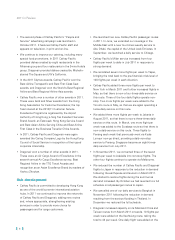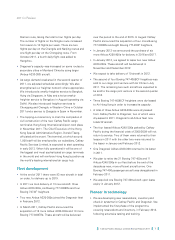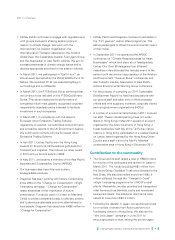Cathay Pacific 2011 Annual Report Download - page 6
Download and view the complete annual report
Please find page 6 of the 2011 Cathay Pacific annual report below. You can navigate through the pages in the report by either clicking on the pages listed below, or by using the keyword search tool below to find specific information within the annual report.
4
777-300ERs and eight Boeing 777-200F freighters. In
January 2012, we announced the purchase of six more
Airbus A350-900s for delivery in 2016 and 2017 and
agreed to lease two new Airbus A320-200s to be
delivered later in 2012. By 2019, we intend to be
operating one of the youngest, most fuel-efficient wide-
body passenger fleets in the world.
Despite the current economic weakness, we have
confidence in the long-term prospects of our cargo
business and in Hong Kong’s role as the world’s leading
international air cargo hub. In addition to bringing more
efficient new freighters into the fleet – we have eight
Boeing 777-200F freighters on order in addition to the 10
Boeing 747-8F freighters referred to above – we are also
building our own cargo terminal. A topping-out ceremony
to mark the completion of civil construction was held in
November 2011. The terminal is expected to begin
operations in early 2013.
During 2011, we have continued our efforts to improve
the services which we provide to passengers. In March
2011, Cathay Pacific introduced its new business class
seat. Feedback from passengers has been very positive.
At the end of 2011, the new seats have been installed in
15 aircraft. In February 2012 we began installing new
premium economy class cabins on our long-haul aircraft.
The new cabins are expected to be installed in 87 aircraft
by 2013. The seats and service in the new cabins will be
significantly better than those in economy class cabins.
We began to install new economy class seats on
medium- and long-haul aircraft in March 2012. The Level
6 Business Class Lounge in The Wing, Cathay Pacific’s
signature lounge at Hong Kong International Airport,
reopened in April 2011 after extensive refurbishment. The
entire refurbishment of The Wing (including the first class
lounge) is expected to be completed by the fourth quarter
of 2012. We continued to develop the passenger network,
launching two new Cathay Pacific routes in 2011 – Abu
Dhabi and Chicago – and increasing frequencies on other
key routes.
Air China plays an increasingly important role in our
business, having contributed 31.1% of our consolidated
profit before tax in 2011. Air China and Cathay Pacific
continue to work together closely. The cargo joint venture
with Air China, in which Cathay Pacific owns an equity
and an economic interest, was formally approved and
established in February and officially launched in May
2011. The joint venture operates from Shanghai under the
Air China Cargo name.
Cathay Pacific joined other airlines, industry bodies and
governments in opposing the European Union’s new
Emissions Trading Scheme (ETS). Introduced on
1st January 2012, ETS is essentially a tax on carbon
dioxide emissions flying into Europe and unfairly penalise
long-haul carriers. We believe that a global approach is
needed for any emissions scheme in order to provide a
level playing field for all airlines.
After a record year in 2010, we faced a number of major
challenges in 2011: the instability of the global economy,
the weakness of the air cargo market, the reduction of
yields in economy class, the impact of natural disasters in
Japan and Thailand, unrest in the Middle East and
continued high jet fuel prices. Looking ahead, economic
uncertainties have continued into the first half of this year
- while these uncertainties continue, we expect pressure
on economy class yields and our cargo business in
particular to remain weak. Fuel prices have risen further.
As a result, 2012 is looking even more challenging than
2011 and we are therefore cautious about prospects for
this year. We will continue to be vigilant in managing our
costs while not compromising the quality of our products
and services or our long-term strategic investment in the
business. Our financial position remains strong. In August
2011, we established a medium term note programme.
The programme provides an additional source of funding
and allows the Company to issue debt in a range of
currencies. The first issue of notes under the programme
took place in October 2011. Further notes were issued in
January and February 2012.
The commitment and hard work of employees across the
Cathay Pacific Group and its subsidiary and associated
companies are central to our continuing success. I take
this opportunity to thank them.
Christopher Pratt
Chairman
Hong Kong, 14th March 2012
Chairman’s Letter



















